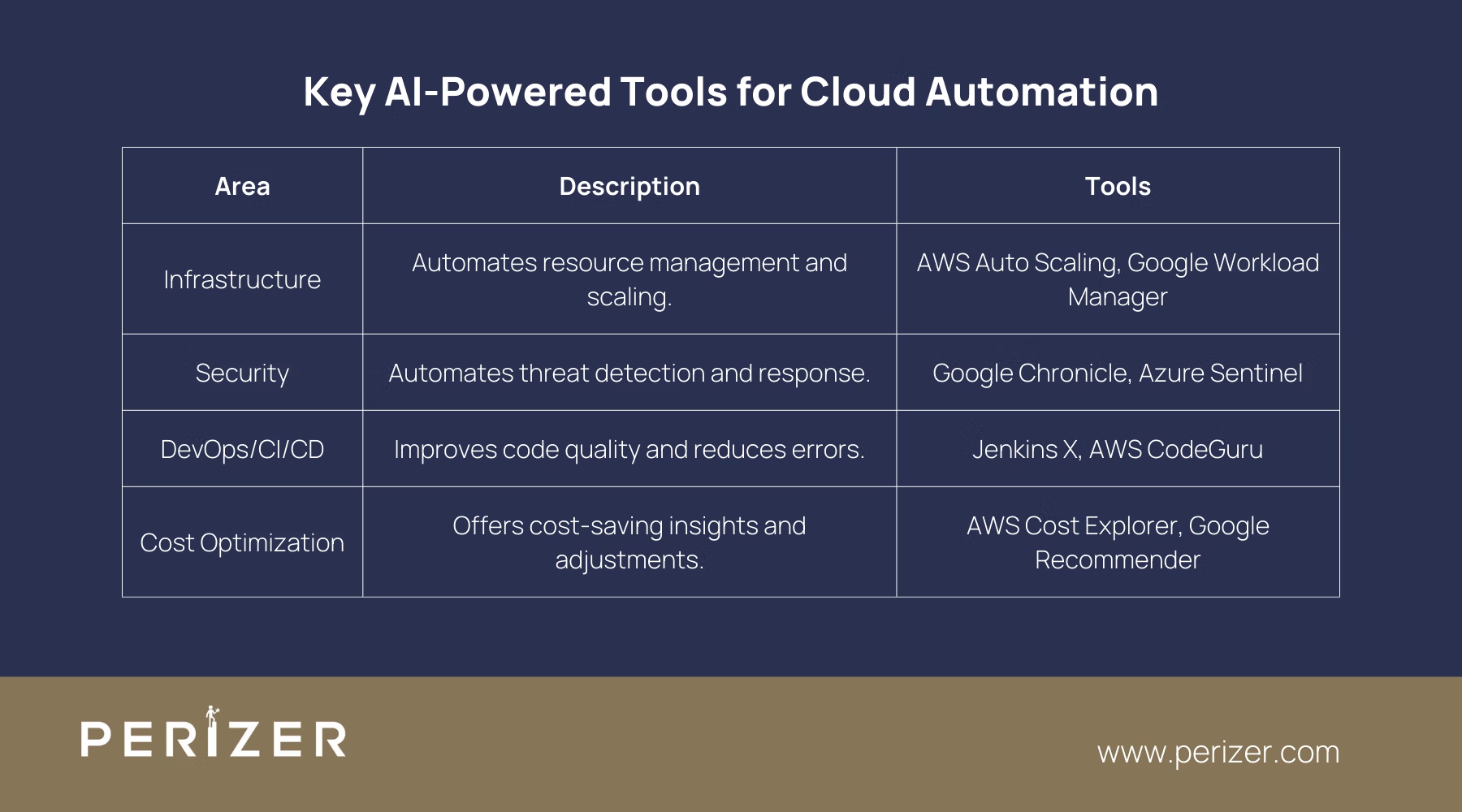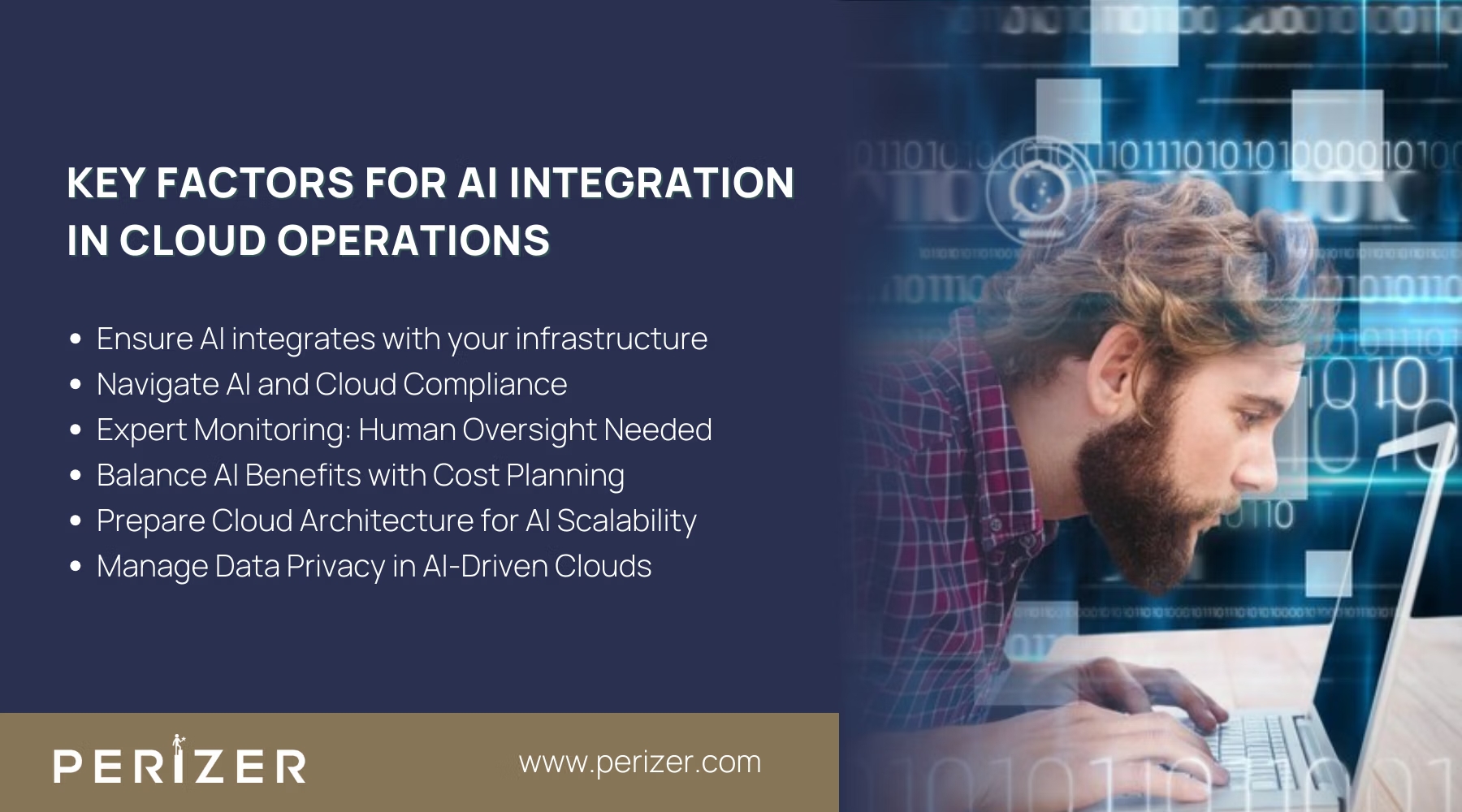AI-Powered Tools for Automating Cloud Operations
Automate cloud operations with AI-powered tools. Learn how AI integration with cloud services enhances security, optimizes costs, and ensures scalability.

Cloud environments are becoming more complex every day, and managing them manually can only take you so far. With constantly shifting workloads, resource demands, and the need for seamless scaling, manual oversight often leads to inefficiencies and the risk of human error. At a certain scale, these traditional methods simply can’t keep up with the speed and precision your cloud infrastructure requires.
To address these growing demands, AI-powered tools offer a more effective approach to managing cloud operations. Instead of manually reacting to issues as they arise, AI continuously monitors your systems, identifies patterns, predicts what’s coming next, and adjusts in real-time to optimize resources and performance. This ensures your cloud infrastructure stays agile and efficient without requiring you to constantly step in and make adjustments.
Let’s see in this guide how AI-driven tools can simplify your cloud operations, offering practical solutions to manage challenges and keep things running smoothly.
The Convergence of AI and Cloud Computing
To understand the real impact AI can have on your cloud operations, it’s important to understand how closely AI and cloud computing are connected. Initially, these technologies developed separately - cloud computing provided scalable infrastructure, while AI focused on advanced data analysis and predictions. But as they’ve come together, they’ve changed the way cloud environments operate in significant ways.
When AI works alongside cloud platforms, it doesn’t just make things more efficient; it reshapes how everything functions. AI constantly learns from your system, spots patterns, predicts issues before they happen, and adjusts in real time to keep everything running smoothly. Instead of manually adjusting resources when traffic spikes, for example, AI takes care of it automatically, ensuring optimal performance without you needing to step in.
This combination is so important because modern cloud environments are simply too complex to manage manually. AI brings the intelligence needed to handle all the moving parts, ensuring your operations stay efficient and seamless.
Key AI-Powered Tools for Cloud Automation

1. AI for Cloud Infrastructure Management
Managing cloud infrastructure is a constantly growing task that demands your continuous oversight. Traditionally, system administrators have had to manually adjust resources, monitor usage, and scale applications.
This can be both time-consuming and prone to human error. AI-powered infrastructure management tools, like AWS Auto Scaling and Azure Automation, help remove this manual burden by using machine learning algorithms to automate these tasks.
How AI Tools Automate Cloud Management?
These AI-driven tools work by monitoring your infrastructure in real-time, using historical data to predict traffic spikes and resource demand. For example, AWS Auto Scaling reviews past usage patterns and automatically adjusts the number of EC2 instances to match the current workload, all without needing your intervention. This ensures optimal use of resources while cutting costs by preventing over-provisioning.
Predictive Analytics for Smarter Resource Allocation
Google Cloud’s AI-powered workload manager takes a similar approach by using predictive analytics to anticipate potential bottlenecks. It adjusts resources in advance, helping to prevent problems before they happen. This level of automation allows for real-time scalability without requiring manual intervention, letting you focus on more strategic priorities rather than day-to-day infrastructure management.
2. AI in Cloud Security
Security is a major concern in cloud environments, and for good reason. As your cloud footprint grows, safeguarding your infrastructure from potential breaches becomes more challenging. AI tools designed for cloud security can automate tasks like threat detection, incident response, and vulnerability management. This allows you to take a proactive approach, addressing risks before they become serious problems.
AI-Driven Threat Detection with Google Chronicle
An excellent example of AI in action is Google Chronicle, a platform that analyzes massive amounts of security data in real-time. It identifies suspicious activity, flags potential threats, and continuously refines its detection algorithms by learning from each incident. This automation scales with your cloud environment, so as your infrastructure grows, your security measures do too - without requiring a larger security team.
Streamlining Responses with Azure Sentinel
Azure Sentinel offers a similar solution by using machine learning to monitor logs, network traffic, and applications for any signs of trouble. It can automatically respond by quarantining affected systems, alerting administrators, or blocking suspicious traffic, ensuring that threats are managed swiftly and efficiently.
3. AI for DevOps and Continuous Integration/Continuous Deployment (CI/CD)
DevOps teams face constant pressure to deliver applications quickly while minimizing errors. AI-powered tools for DevOps pipelines play an important role in automating parts of the Continuous Integration/Continuous Deployment (CI/CD) process. These tools help reduce human error, improve code quality, and ensure smoother, more reliable deployments.
Enhancing CI/CD with Jenkins X
Jenkins X, for example, integrates AI to streamline testing, deployment, and scaling by analyzing logs and historical build data. By detecting patterns that may lead to failures, Jenkins X helps prevent bugs from reaching production, ensuring more stable releases and reducing the need for last-minute fixes.
Smarter Code Reviews with AWS CodeGuru
AWS CodeGuru goes even further by automating code reviews with AI. It scans your codebase for inefficiencies and security vulnerabilities, offering specific recommendations for improvements. This helps identify issues earlier in the development cycle, allowing you to address problems before they escalate and improving the overall quality of your applications.
4. AI for Cost Optimization
One of the biggest advantages of AI in cloud operations is cost optimization. Keeping cloud expenses under control isn’t always easy, especially with fluctuating workloads. AI-driven tools like AWS Cost Explorer and Google Cloud’s Recommender offer useful insights into your spending, helping you manage costs more effectively.
How AI Tools Help Control Cloud Costs?
These tools constantly analyze your resource usage to spot underutilized services, over-provisioned resources, and unnecessary expenses. AWS Cost Explorer, for instance, uses machine learning to predict future usage based on historical data. It provides recommendations like switching to reserved instances or reducing storage consumption to lower costs.
Optimizing with Google Cloud’s Recommender
Google Cloud’s Recommender works similarly. It looks at your cloud usage and suggests cost-saving measures, such as rightsizing virtual machines or switching to lower-cost services. By adopting these AI-driven solutions, you can keep your cloud operations cost-effective while maintaining top performance.
Considerations for Implementing AI in Cloud Operations

When bringing AI into your cloud operations, a few key things need attention. First, take a close look at how AI will integrate with your current setup. You might need to make some adjustments, but the aim is to ensure these tools fit smoothly without causing disruptions.
Data privacy is another big factor. Since AI depends on large sets of data, having strong data management practices is more important. You’ll want to make sure everything aligns with regulations like GDPR or HIPAA to avoid any compliance issues.
Lastly, while AI automates many processes, it’s not fully hands-off. You’ll still need experts to monitor its performance, fine-tune it, and step in when needed to keep everything running smoothly and accurately.
What’s Next for AI in Cloud Operations
AI is moving toward even more advanced automation in cloud operations. A key development is the emergence of autonomous cloud platforms - systems that handle tasks like resource management, scaling, and security with minimal human involvement. These platforms use AI to make real-time decisions and adjustments, leading to more efficient and reliable operations.
AI is also becoming essential for managing multi-cloud and hybrid environments. As organizations increasingly use multiple cloud providers, AI tools will help optimize workloads across platforms, ensuring efficient use of resources while controlling costs.
As AI technology continues to grow, its presence in cloud management will rise. Adopting these tools now will ensure your cloud infrastructure remains scalable, secure, and prepared for the advances that AI will bring.
Conclusion
AI is fundamentally changing the way cloud operations are managed, making everything from resource management to security much simpler. Instead of handling these tasks manually, AI tools help you automate and optimize them, keeping your cloud infrastructure running smoothly, even as it grows more complex.
By integrating AI, you’re not just improving your current operations - you’re setting up your cloud environment to scale easily and stay secure as your needs evolve. Now’s the perfect time to adopt AI and improve how you manage your cloud systems.
FOCUSED, FAST, GOVERNMENT READY
Stay Tuned With Our Latest Insights

Staff Augmentation
Learn how to select the perfect IT outsourcing partner to promote your team’s capabilities, improve productivity, and drRead more...

Staff Augmentation
Find the perfect staff augmentation partner by aligning your goals, evaluating expertise, managing costs, and ensuring aRead more...

Cyber Security
We focus on understanding the needs, behaviors, and expectations of your users through extensive user research. This infRead more...